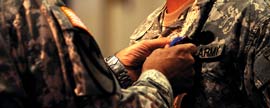This article is the first in a series about inspections. As I travel, Soldiers share with me the challenges they are facing. A leader recently told me that they were inundated with inspections. This began a discussion about why inspections are required and what value they bring to the table.
Click to read Part 2 of this series: U.S. Army Inspections: Planning & Preparation
Click to read Part 3 of this series: U.S. Army Inspections: Barracks Inspection

Soldiers in combat already understand the importance of pre-combat and pre-execution inspections. However, Soldiers may require more explanation of garrison inspections to understand their purpose and value.
The Importance of Inspections
Our combat-tested Soldiers readily understand the value of conducting pre-execution and pre-combat checks. These inspections have an immediate and definite purpose, “If you don’t do your job to maintain yourself and your equipment, someone is going to die.” Therefore Soldiers fully understand the value of these inspections. As combat operations draw down, more Soldiers will be increasingly required to participate in standard garrison inspections that focus on equipment and personnel. These inspections tend to lack the immediacy of combat operations. As this occurs it is imperative that leaders not only inspect their Soldiers but explain to them the value of the inspection. Leaders must ensure Soldiers understand why they are performing the tasks at hand and how these tasks are related to the mission. When Soldiers understand “Why” they usually perform better.
Inspections typically have several common themes and are designed to help leaders verify the condition of an item or resource, and help enforce standards & discipline. Properly executed inspections are instrumental in establishing unity and standards. In all inspections; the inspector gains a better understanding of the morale of individuals and the esprit de corps of the element being inspected.
Inspection Techniques
There are several different inspection techniques. These include:
Informal: An informal inspection can be something as simple as the squad leader walking through the ranks in the morning prior to formation, observing and chatting with his Soldiers or walking through the barracks area to gain a better understanding of their living conditions and state of mind.
Formal: Formal inspections are usually scheduled ahead of time for an intended purpose. This may be an in-ranks inspection by the company commander or an annual higher headquarters inspection program.

Unannounced health and welfare inspections are not only effective for checking for unauthorized items, but can be used to confirm Soldiers are keeping up with standards.
Announced: Announced inspections provide Soldiers the ability to prepare. Inspectors identify the time, location, and resources that will be checked. Some resources could include: uniforms, equipment, and personnel. Announced inspections are usually used when a command wants to assess or evaluate training or standards.
Unannounced: Unannounced inspections are used by commands to spot-check standards and gain better insight into a Soldier’s behavior when confronted with non-routine situations. They are commonly used for health and welfare inspections (checking for illegal or unauthorized items). Unannounced inspections can also be used to verify training standards. For example, the platoon sergeant might bring a crew served weapon to formation one day and ask members of the platoon to disassemble, assemble and function-check the weapon. The purpose of this would be to verify the capability of the element and determine areas that need improvement.
Random Sampling: The random sampling technique involves only checking a percentage of the element or equipment. If the platoon sergeant is conducting a TA-50 inspection, he might check the overall layout of the platoon but then only check 5-6 items from each Soldier’s layout. He may also choose to only check only 1 person per squad looking at 100% of their items. Leaders must use caution when using this approach as it is easy to overlook excellent performers during random inspections. Always seek out exceptional performers.
In-depth Sampling: As opposed to the random sampling technique, in-depth sampling means checking 100% of everything involved in the inspection. This gives the leader the most thorough results but is also very time consuming.

Most inspections utilize more than one of these techniques. For example you may have a formal, unannounced health and welfare inspection or an informal unannounced in ranks inspections.
There are many types of inspections and they have various purposes. Future articles will explore the following types of inspections: In-Ranks Inspection, Barrack Inspection, Health and Welfare Inspection, TA-50 Inspection, and Equipment Maintenance Inspection
Remember the key to conducting an inspection is to ensure you have a clear purpose that your Soldiers understand. Most Soldiers want to do well . Keeping them informed and providing clear standards will help to ensure exceptional performance during inspections. Failure to follow this guidance usually results in a frustrated and unmotivated organization.
Read The Trainer: A Training Guide for all ranks for more information about Army Training techniques, tactics, and procedures including training best practices and example scenarios.














Comments
Joseph Kishel
CSM,
You are spot on with your writing. I enjoy this site alot. Thank-you for providing purpose, direction and Motivation.
SFC Kishel
First Sergeant
USAREC
15 years Operational Army Military Police
2 Combat Tours
6 years in USAREC